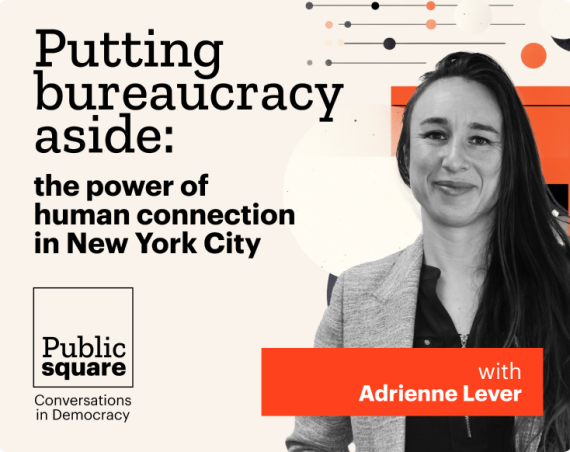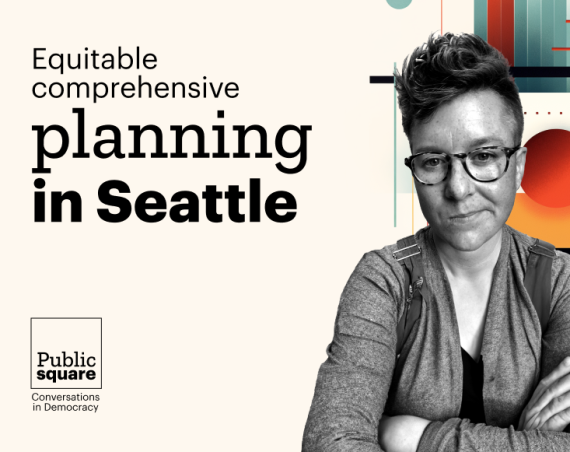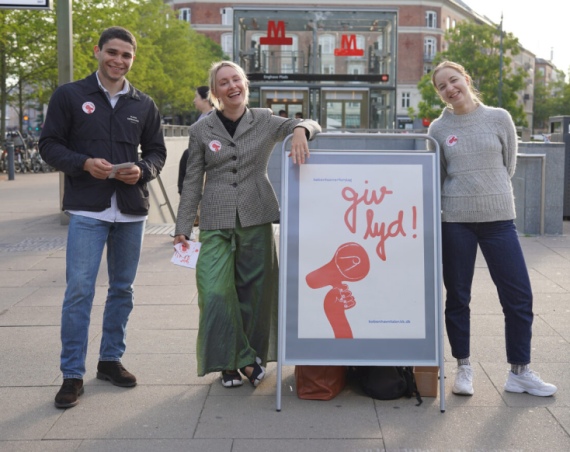Have you ever wondered how to involve your community in budgeting, urban planning, or even regenerating former military bases? The examples from CitizenLab’s international community, handpicked by our team of engagement experts, illustrate the power of collaborative decision-making. Discover how these communities are shaping their future together.
- Toronto Centre engages the community in shaping neighborhoods with a CA$2,250,000 participatory budgeting project (Canada)
- London Borough of Newham lets residents vote for favorite neighborhood improvement projects (United Kingdom)
- Düsseldorf plans more green spaces with residents (Germany)
- Town of Altena empowers residents with a participatory budget (Netherlands)
- Falkirk Council surveys residents on 20mph speed limits (United Kingdom)
- Harderwijk reimagines old military site into a vibrant community space (Netherlands)
Toronto Centre engages the community in shaping neighborhoods with a CA$2,250,000 participatory budgeting project (Canada)
For our first example, we’re packing our (virtual) bags and heading to Canada! To the vibrant and diverse Toronto Centre, to be precise, to have a look at their participatory budgeting initiative.
Toronto Centre, comprising 14 unique neighborhoods, has been thoughtfully divided into six zones. This ensures each area receives the attention and resources it needs, facilitating a smooth and effective participatory process. Three of these zones have been selected to pilot this exciting project.
Let’s break down the project. First, residents are invited to pin their ideas on an interactive map, allowing them to visualize exactly where and how their suggestions could come to life. A dedicated folder has been created on the engagement platform for each zone. This organization simplifies navigation for participants and ensures that ideas and discussions are relevant and specific to each zone, fostering focused and effective engagement.
Being so diverse, Toronto Centre goes the extra mile to engage as many residents as possible with activities like the “PB In-person Tour”. They set up booths in parks, community centers, and at major events like PrideTO, for residents to register ideas in person, engage in conversations, and provide feedback.
Example of the voting on Toronto Centre’s engagement platform
In the second phase, each submitted idea undergoes a thorough review by city staff, who assess feasibility and calculate costs to guarantee practicality and sustainability.
In phase three, residents vote on the ideas they believe will best enhance their community through CitizenLab’s Participatory Budgeting tool.
After the votes are in and the winners are announced, the projects will be submitted to the City Council. Upon approval, these ideas will transform from proposals on a map to tangible changes in the community.
Have a look at Toronto Centre’s project yourself
London Borough of Newham lets residents vote for favorite projects to improve neighborhoods (United Kingdom)
The People Powered Places program of the London Borough of Newham entered a new phase in October 2023.
From October 21 until November 12, Newham’s community was invited to decide how a substantial £1.6 million funding pot should be distributed across eight Community Neighborhoods in what was called the ‘Big Vote’.
What sets this initiative apart is its inclusive approach to voting. Recognizing the diverse demographic of Newham, the program opened its doors digitally on the CitizenLab engagement platform, and in real life in libraries and community centers.
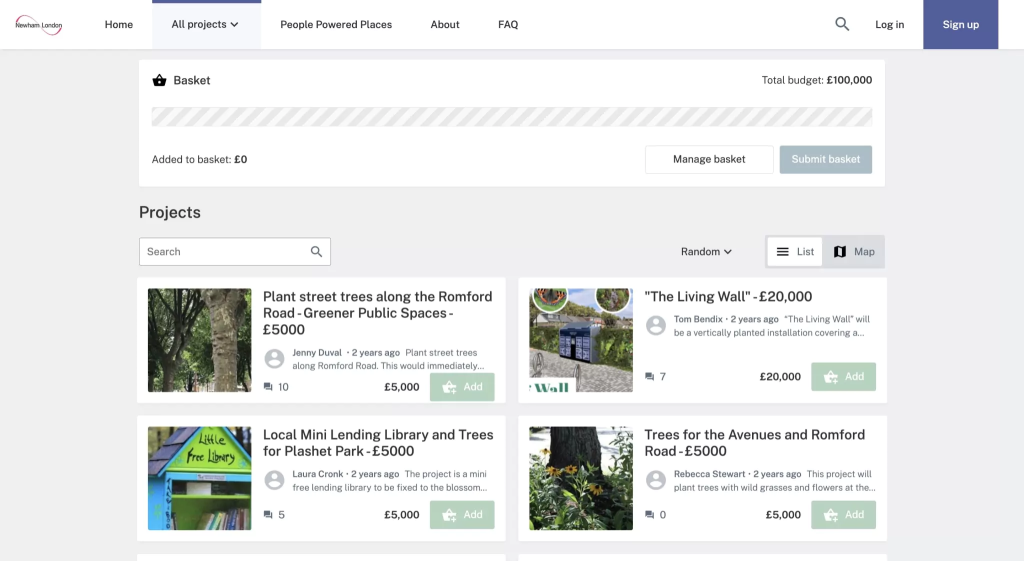
Screenshot of Newham’s engagement platform
All residents 13 and older could vote for their 10 favorite projects using CitizenLab’s Approval Voting method – or select 10 projects on their paper ballot. Also, younger children could vote under adult supervision at local events and libraries. This blended engagement approach ensured that every resident, regardless of age or tech-savviness, had a say in the future of their neighborhood.
Impressively, this led to nearly 8,000(!) residents casting their votes, showcasing a high level of community involvement and enthusiasm.
To guide residents through the process, the engagement team crafted a comprehensive FAQ and video tutorial, offering clarity and support.
Check out Newham’s praised People Powered Places program or read more about it in our case study
Düsseldorf plans more green spaces with the community (Germany)
“Always wanted to become a city planner?” With this intriguing question, Düsseldorf is sparking creativity and inviting residents to actively shape their local environment. The project to develop a green spaces framework plan for District 9, spearheaded by Düsseldorf’s Marketing department, is turning city planning into an engaging and collaborative endeavor – with a little help from the CitizenLab platform.
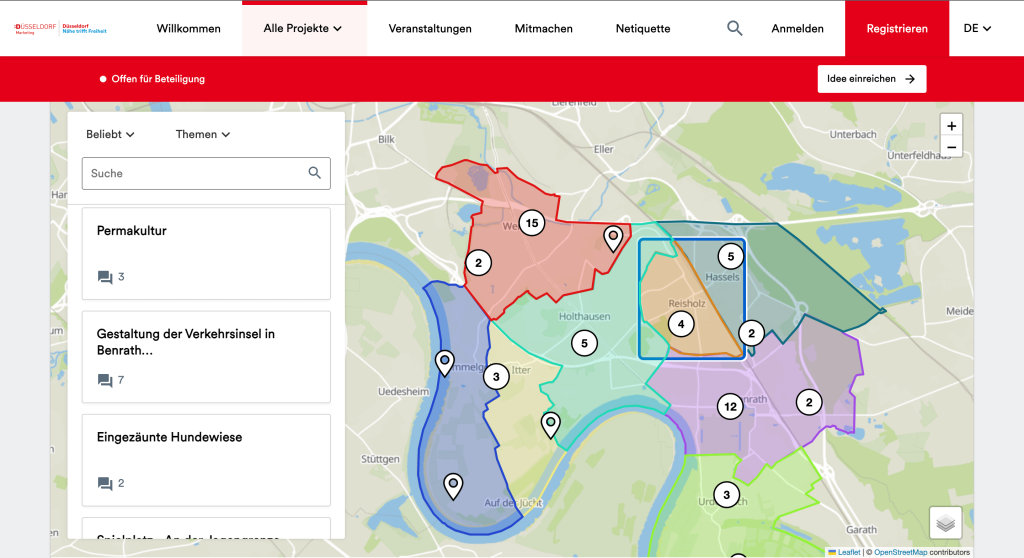
Example of the interactive map on Düsseldorf’s engagement platform. The text was originally in German and this depiction is machine-translated.
Using the interactive Mapping tool, residents can pinpoint specific locations within neighborhoods on a custom-layered map of the District and suggest areas for new green spaces, playgrounds, or communal open areas.
This engagement method’s ability to foster community dialogue is particularly powerful. Apart from submitting ideas, residents can also engage in conversations, build upon each other’s suggestions and create a dynamic exchange of visions for their district.
Besides adding ideas on a map, participants can also add general suggestions on an ideation forum, or share their opinions about what’s good and what can be further improved through a survey on the platform.
Explore Düsseldorf’s engagement platform
Town of Altena empowers residents with a participatory budget (Netherlands)
Altena is taking an exciting step in its community engagement journey with its “Resident Budget” project. This one is all about getting residents involved in making their town a better place.
The project focuses on seven important areas: activities for young people, support for volunteers and caregivers, clear communication, addressing loneliness, ensuring everyone can participate, dealing with substance use, and tackling poverty.
For starters, everyone in Altena was encouraged to bring their creative thoughts to the table. To assist residents in shaping their ideas, especially on the financial side, the town’s budget team prepared a template business plan – a tool to evaluate the financial aspects of proposals, ensuring that ideas are both creative and financially viable. Additionally, the team offered live help.
Following the idea submission phase, the town analyzed each idea, considering feasibility, alignment with the requirements, and potential costs. To keep the community informed and engaged, they utilized the tag system on the town’s CitizenLab platform, clearly indicating the status of each idea – whether or not it was moving forward to the voting phase.
Example of the suggested ideas on Altena’s engagement platform. The text was originally in Dutch and this depiction is machine-translated.
Then, residents aged 12 and above cast their votes digitally on the platform or in person at the town hall. For the digital exercise, Altena’s engagement team uses CitizenLab’s Participatory Budgeting tool – each resident has a virtual budget of €50,000 to distribute across their favorite projects.
Once all ‘votes’ are counted, Altena announces the results on their engagement platform and proceeds to implementation, together with the applicants of the chosen ideas. The original suggesters, supported by interested neighbors and the municipality, lead in implementing these projects.
Falkirk Council surveys residents on 20mph speed limits (United Kingdom)
To enhance road safety and promote sustainable travel, Falkirk Council, in line with the Scottish Government’s National Strategy, launched a survey to gather residents’ views on implementing 20mph speed limits in their areas.
Using CitizenLab’s efficient built-in Survey tool, the council reached out to its residents, inviting them to share their opinions on this significant change. The response was overwhelming – 1,568 residents participated, reflecting the community’s strong interest in road safety.
Example of the survey on Falkirk’s engagement platform
Although small, this project highlights a crucial aspect of community engagement: the power of addressing topics that resonate deeply with residents. By focusing on road safety, a concern shared by many, Falkirk Council gathered valuable insights and saw a surge in resident sign-ups on their platform. This approach demonstrates how targeted, relevant topics can effectively engage communities and drive participation.
Falkirk Council will communicate the survey results on the platform, ensuring transparency and keeping residents informed about the steps being taken based on their feedback.
Harderwijk reimagines old military base as a vibrant community space (Netherlands)
Local governments often shy away from launching extensive, long-term projects due to the challenge of maintaining public interest and engagement over an extended period. However, the municipality of Harderwijk in the Netherlands is embracing this challenge with determination. They’re steadfast to set an example with their ambitious plan to transform the former Kranenburg barracks, an old military site, into a vibrant and multifaceted neighborhood. For this project, set to run until December 2027, they actively invite the residents to contribute their ideas.
To lay the foundations for a development framework, Harderwijk is asking the community’s opinion on a series of topics through surveys on the CitizenLab platform – from the number of homes to sustainability, heritage, and mobility. This segmented approach ensures that feedback is targeted and relevant, allowing residents to enagge effectively.
Screenshot of Harderwijk’s engagement platform. The text was originally in Dutch and this depiction is machine-translated.
Recognizing the complexity of this long-term redevelopment, Harderwijk has created a dedicated landing page on the CitizenLab platform. This central hub is organized with individual folders for each sub-theme, making it easy for residents to find and contribute to the topics that matter most to them.
To kickstart engagement and add an element of excitement, participants can win movie tickets. With this clever strategy, the engagement team wants to spark initial interest and get the community talking about the project. By linking engagement to a fun and accessible reward, you can draw in a diverse range of voices right from the start.
Once this framework is established, the municipality and residents will collaboratively work on the master plan and designs in later phases, ensuring that the redevelopment is a true co-creation between the government and its community.
Check out Harderwijk’s impressive use of the platform’s capabilities

